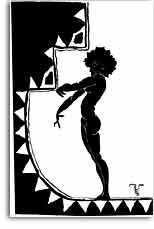
|
|
 |
||||||
|
|
|||||||
In spite of his modest literary and artistic output and the equally small amount written about his life, Richard Bruce Nugent was a principal player in the New Negro movement. His unique and unorthodox personal style and sexual conventions snubbed the established mores of the time. Nugent’s lifestyle was that of the ultimate bohemian. Because of the notoriety surrounding him, and to avoid the disapproval of and embarrassment to his family, he assumed the pseudonym of Richard Bruce. It is this pseudonym that is often attached to his writings and drawings. He has been described as a “bizarre and eccentric vagabond poet,” and “a non-conformist who refused to accept so-called middle class standards.” Other attributes used to describe him were “cutting, good-looking, great sense of humor, and intelligent.”
Richard Bruce was born in the Washington, DC to a family of high social position in the black community. His parents, Richard Henry Nugent and Pauline Minerva Bruce, had two children. His mother was an accomplished pianist who was trained as a schoolteacher. His father was a pullman porter. Richard Bruce Nugent attended public grade schools and Dunbar High School.
Nugent was a frequent participant at Georgia Douglas Johnson’s famous artistic salon where writers and intellectuals congregated in Washington. It was at one of those artistic gatherings that he met Langston Hughes. They immediately became the best of friends. According to Eric Garber in the Dictionary of Literary Biography, from their first meeting it was evident that “Nugent was captivated by the rising young poet’s [Langston] handsome appearance, his worldly experiences, his gentle manner, and his literary success.” (213)
Throughout the Renaissance, Hughes and other writers offered encouragement and support to Nugent’s literary and artistic efforts. “Shadows,” Nugent’s first published poem, was rescued from the trash by Langston Hughes and was eventually sent to the Opportunity magazine. “Shadows” was reprinted in Countee Cullen’s Caroling Dusk (1927). Alain Locke’s The New Negro (1925) contained “Sadhji,” Nugent’s first published short story. This story came about surreptitiously. Locke asked Nugent to write a brief explication of a drawing that he had done of a young African woman. The narrative ended up being more useful than the graphic that Nugent had done. Locke continuously encouraged Nugent in his artistic endeavors; they knew each other through their family connections.
 During
the summer of 1926, Nugent was
a part of a group of black artists who envisioned a literary periodical to break
with the black literary establishment. This quarterly was known as
During
the summer of 1926, Nugent was
a part of a group of black artists who envisioned a literary periodical to break
with the black literary establishment. This quarterly was known as ![]() Fire!!.
Fire!!.
To deliver his message in the short story, Richard Bruce used elliptics throughout the narrative. In electing to use elliptics, as a style to emulate speech and thought processes, he aimed to approximate actual speech, giving short and long pauses to reflect a more nature speech pattern. Nugent was also involved with a second magazine undertaking. In 1928, he served as associated editor of Harlem: A Forum of Negro Life. The only issue of Harlem was published in November 1928. In its short life, Richard Bruce wrote the theatre reviews.
Nugent did not follow the usual expectations and norms of a society that he felt created restrictive boundaries. In his own words, he stated that he was always called flamboyant. His unwillingness to live up to societal expectations is exemplified in his assessment of Locke. According to Nugent, “[Alain] Locke had decided that he had his finger on the pulse of every black person who was doing anything. Almost everybody listened to his dictates, except Wally [Wallace Thurman] and me.” (Smith, p. 216)
In 1952, Nugent married Grace Elizabeth Marr. He admits without any hesitation that the love he had for her was not a physical love or lust. They were married for seventeen years. Grace died of ovarian cancer in 1969 and Nugent of congestive heart failure seventeen years later in 1987. At the time of his death, he was living in Hoboken, New Jersey.
Garber, Eric, “Richard Bruce Nugent,” in Dictionary of Literary Biography. vol.51, Afro-American Writers from the Harlem Renaissance to 1940, edited by Trudier Harris (Detroit: Gale Research Inc., 1987).
Smith, Charles Michael, “Bruce Nugent: Bohemian of the Harlem Renaissance,” in In the Life: A Black Gay Anthology, edited by Joseph Beam (Boston: Alyson Publications, Inc., 1986).
“Sadhji,” in ![]() The
New Negro, edited by Alain LeRoy Locke (New York: Boni, 1925), pp.113-114.
The
New Negro, edited by Alain LeRoy Locke (New York: Boni, 1925), pp.113-114.
“Smoke, Lilies, and Jade,” in ![]() Fire!!,
(November 1926): 405-408.
Fire!!,
(November 1926): 405-408.
biographies | harlem
renaissance books | links | timeline
black renaissance home | dclibrary.org
home
The Black Renaissance in Washington, D.C., 1920-1930s
http://www.dclibrary.org/blkren/
| last updated June 20, 2003